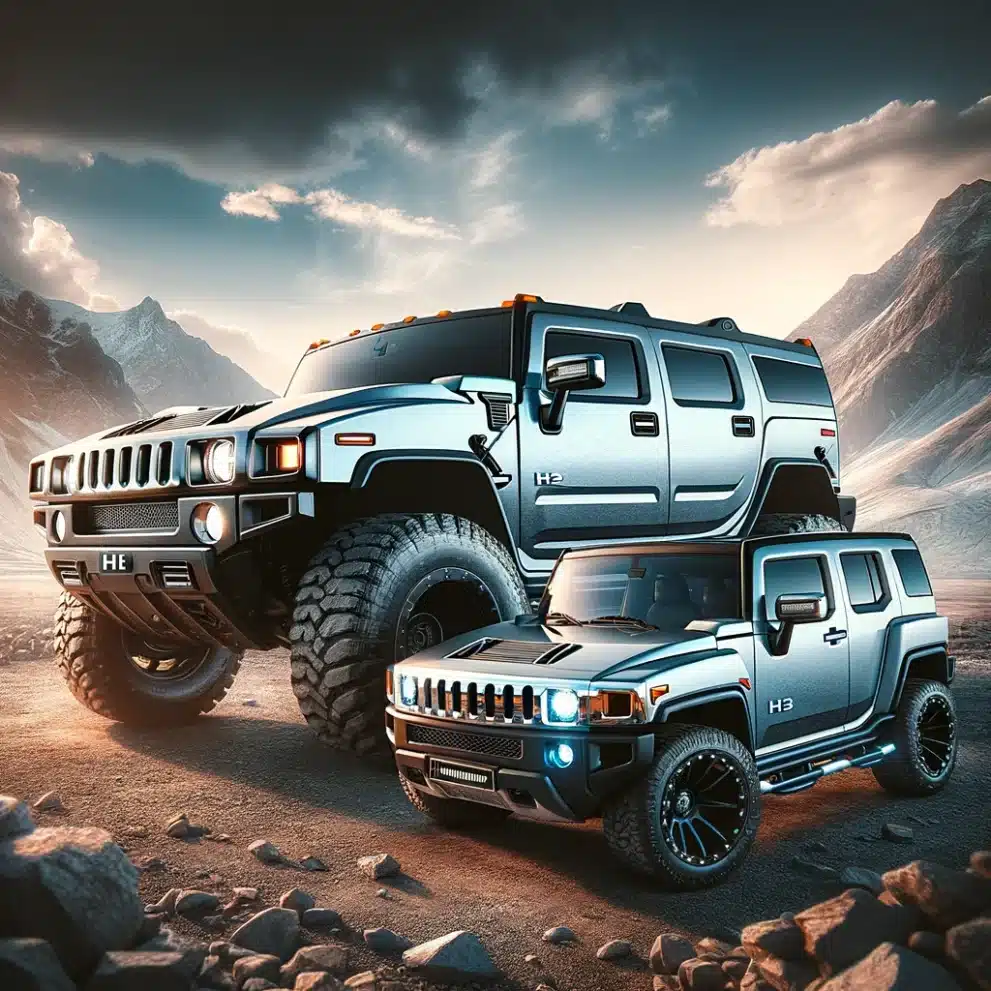
The Hummer is a brand of trucks and SUVs, originally known for its military use before being adapted for civilian markets. The Hummer’s origins trace back to the High Mobility Multipurpose Wheeled Vehicle (HMMWV), commonly known as the Humvee, which was created by AM General for the U.S. military. This vehicle gained widespread recognition during the Gulf War for its ruggedness and off-road capabilities.
Capitalizing on its military fame, the Hummer was introduced to the civilian market in the early 1990s. The first model, the Hummer H1, closely resembled the Humvee and was renowned for its robust construction, impressive off-road ability, and unique, boxy design. However, it was also known for being quite large and less fuel-efficient, reflecting its military heritage.
As the brand evolved, it introduced the H2 and H3 models, which were designed to be somewhat more consumer-friendly. The H2, while still large and imposing, was a step towards a more typical SUV design and was more practical for everyday use. The H3 further scaled down the size and was the smallest of the three, aimed at a broader market with more urban-friendly dimensions and better fuel efficiency.
Despite their popularity in certain circles, Hummers faced criticism for their environmental impact, primarily due to low fuel efficiency and high emissions. This criticism grew stronger in the 2000s, coinciding with rising fuel prices and growing environmental consciousness.
The Hummer brand was a part of General Motors (GM), and during the financial crisis of 2008-2009, GM, facing financial difficulties, decided to discontinue the Hummer line. The brand was officially phased out in 2010.
However, in a turn of events aligning with the growing trend towards electrification in the automotive industry, GM announced a revival of the Hummer brand in 2020, this time as an all-electric sub-brand under its GMC marque. The new Hummer EV, introduced as a pickup truck and an SUV, is aimed at combining the ruggedness and off-road capabilities of the original Hummers with modern, environmentally friendly electric powertrains. This move represents a significant shift from the Hummer’s original image and reflects the evolving priorities of the automotive industry and consumers.
Hummer H2 vs. H3
The H2 and H3 Hummer models, both descending from the original military-inspired Hummer H1, were designed with the consumer market in mind, but they differ significantly in size, design, and target audience.
The Hummer H2, introduced after the H1, retained much of the imposing stature and rugged appeal of its predecessor. It was large, with a bold design that made a statement on the road. Its size and capabilities made it popular among those looking for a vehicle with strong off-road prowess coupled with a luxury feel. The H2 was built on a modified platform of the Chevrolet Tahoe, which contributed to its large size and heavy weight. This model was equipped with a powerful engine and had a spacious interior, providing comfort and utility but at the expense of fuel efficiency.
In contrast, the Hummer H3 was a smaller, more refined version aimed at a broader market. It was based on the platform of the Chevrolet Colorado, making it more compact and suitable for everyday driving, especially in urban settings. While still maintaining the distinctive Hummer appearance, the H3 was less imposing and more practical for those who didn’t need the oversized nature of the H2. Its smaller size meant better maneuverability and improved fuel efficiency compared to the H2, though it still lagged behind typical SUVs in this regard. The H3 offered a more balanced approach, providing off-road capability and Hummer’s signature style but in a more accessible package.
Essentially, the H2 was about making a bold statement with size and power, ideal for those who valued the Hummer’s unique presence and off-road capabilities without much concern for fuel economy. The H3, meanwhile, was a response to the demand for a more practical and city-friendly vehicle, retaining the brand’s essence but in a less extreme form. Both models reflected different aspects of the Hummer’s identity – the H2 emphasized its roots and legacy, while the H3 represented an adaptation to a changing market and consumer preferences.
Hummer sales by year
The sales figures for the Hummer H2 and H3 over the years reflect the fluctuating popularity of these vehicles, influenced by factors like market trends, economic conditions, and changing consumer preferences.
For the Hummer H2, which was marketed from 2002 until 2009, the sales in the United States were as follows:
- 2002: 18,861 units
- 2003: 34,529 units
- 2004: 29,898 units
- 2005: 33,140 units
- 2006: 17,472 units
- 2007: 12,431 units
- 2008: 6,095 units
- 2009: 1,513 units
The total sales for the Hummer H2 during its production years amounted to 153,026 units. The sales peaked in 2003, reflecting the initial excitement and novelty of the vehicle. However, they began to decline steadily thereafter, likely due to factors such as rising fuel prices and growing environmental concerns.
On the other hand, the Hummer H3, which was in production from 2005 to 2010, had the following sales figures in the United States:
- 2005: 33,140 units
- 2006: 54,052 units
- 2007: 43,431 units
- 2008: 20,681 units (plus 692 units of the H3T model)
- 2009: 5,487 units (plus 2,046 units of the H3T model)
In total, the combined sales for the Hummer H3 and the H3T model were 159,529 units. The H3 saw its best year in 2006, but like the H2, its sales declined in the subsequent years. The decline in sales of the H3 could be attributed to the same factors impacting the H2, as well as the economic downturn during the late 2000s.
The sales trends for both the H2 and H3 indicate that while these vehicles initially garnered significant interest due to their unique design and off-road capabilities, their appeal waned over time, particularly as economic and environmental considerations became more pressing for consumers.




 Share
Share Tweet
Tweet Share
Share




Comment